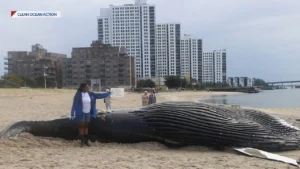
Whale Autopsies Reveal Leading Cause of Death
min read
Christina Thompson (Anchor, EarthxNews): Our next guest is pointing to a different culprit behind the whale deaths—climate change and shipping lanes.
Regina Asmutis-Silvia, the executive director at Whale and Dolphin Conservation in North America. Regina, thank you so much for coming on, for sharing your expertise. I wanted to ask: in your opinion, what is causing these whale deaths?
ASMUTIS-SILVIA: Based on the information that’s available, based on the ability to do the necropsy and the examinations, most of the animals that have been examined have evidence of vessel strikes. We’ve seen a number of species that have had a change in distribution as a result of a change in climate and changing prey bases—where they’re going to go look for food, where they’re finding food. There’s been some fishery management changes that have led to an increase in abundance of menhaden, a small schooling fish, particularly in the Mid-Atlantic and the New York fight area. And we don’t know how whales find their food, but they’re good at it. So there have been an increase in the number of whales going into that area looking for food. There is a increase an activity; it’s not a place that we would have probably had management measures previously because that area wasn’t considered to be a high use area for a lot of different whale species in the past. And so seeing more whale watching happening in that area regularly was another indication of the fact that whales are being sighted there on a more consistent basis, and more whales in an area—particularly in a place that has a lot of boat traffic—is unfortunately going to lead to issues where you’re going to have vessel strikes.
THOMPSON: Is there anything else that you can point to other than boats, entanglement, relocation because of climate change that you can blame for the whale deaths?
ASMUTIS-SILVIA: I mean, I think that it’s really important for people to understand that it’s not really super simple to always know why a whale died. These animals are warm-blooded animals. They are encased in a thick blubber layer. They start to decompose the second they die, and they’re not dying on the beach. They’re dying somewhere at sea, starting to decompose before the currents bring them up onto the beach. At that point, there are some really skilled stranding responders in the Mid-Atlantic area, in particular, that are going out and trying to examine these carcasses. And a postmortem on a large whale is a lot of work. And it’s not something simple to do once the tissue starts to decompose. So, when they do these postmortems and they’re looking inside of whales, or looking for things like— Is there bruising? Are there broken bones? Are there evidence externally on signs of entanglements? Are there ligature marks? Are there are there cases of disease? They’re looking at organs—if they’re intact enough to be able to examine them—doing histology, trying to figure out if there’s parasite loads. You know, the question of ears has come up quite a bit, and the small hairs that are on the ear decompose almost instantly after those animals die. So there’s not, it’s not so simple to have a carcass wash up on the beach and do the extensive exams that I think some of the public think are possible.
So where those exams can occur, and what they can find? Those cases, have—in that particular area—really have been pointing to vessel strikes.
THOMPSON: Obviously, a lot goes into this, but we do appreciate you coming on and sharing your expertise. Regina Asmutis-Silvia, thank you!
ASMUTIS-SILVIA: Thanks for having me.
